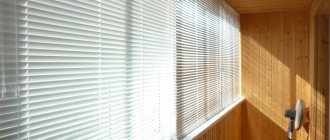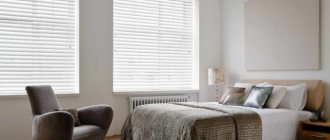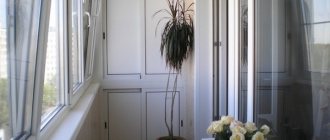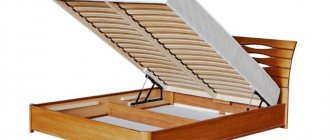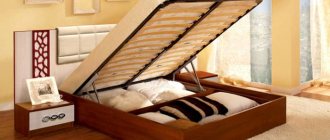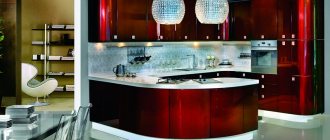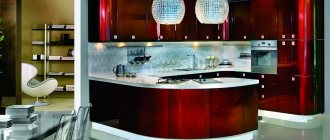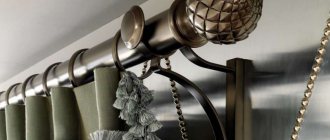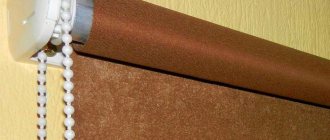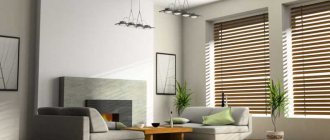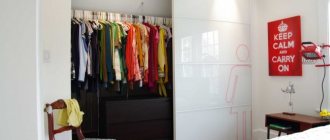The balcony is the most illuminated part of the apartment or house.
This is not only a big advantage of the room, but also causes some inconvenience. For example, on a hot day, the balcony heats up the room adjacent to it, house plants burn under the influence of direct sunlight, and the bright light from lanterns disturbs you at night.
That is why you can see a variety of curtains on almost all modern balconies. Let's figure out which curtains are best suited for placement on balcony windows.
Which blinds are best to hang?
A few recommendations for choosing:
- It is not recommended to choose vertical slats for a small balcony space.
- For a loggia with sliding windows, both vertical and horizontal models with ceiling mounting are suitable.
- For loggias located on the south side, it is advisable to use products made from denser materials.
- It is better to design small balcony windows with horizontal structures, with the type of glass mounting.
- It is better to choose the size of the blinds slats 5-10 cm smaller than the balcony frame.
Horizontal blinds on the loggia: choose your option
Cassette horizontal blinds for loggias today are apparently the most popular of all. They are very practical and easy to use. At the same time, they are not very expensive.
Blinds on the loggia must perfectly perform their protective functions and provide a pleasant aesthetic appearance. Horizontal blinds best meet these requirements.
Such models are attached directly to the glass unit. This allows them to be fixed when ventilating or opening the window structure. These products are much easier to maintain, but, unfortunately, are not suitable for aluminum frames.
Horizontal blinds are usually:
- Cassette type Izolight and Izorta. These are one of the most popular types of plastic blinds for windows, which have a huge number of advantages compared to vertical models. These designs are quite practical and effective. The design of the systems differs somewhat from each other.
- Aluminum Holis. The usual classic version with stick-rope control. Their main advantage is their low price, but they are not entirely convenient to use.
- Wooden. An option suitable for eco-style. But these structures are quite heavy. Their main advantage is environmental friendliness and excellent appearance. They are distinguished by their high cost.
- Bamboo. They are lighter in comparison with wooden structures, have more color shades, but are also the most expensive in cost.
- Plastic. An economical option. In addition, they are easy to care for and come in a variety of colors.
Recently, wave-type blinds have become increasingly popular. They have an excellent aesthetic appearance. The essence of the design is the wave-like shape of the edge of the lamella.
Curtains can be used as sun protection on the balcony. Read the article for tips and recommendations for choosing: https://homeli.ru/dekor/shtory/shtory-na-okna.
Types of structures
There are several design varieties of blinds, each of which allows you to choose the ideal solution for decorating your loggia.
Horizontal models
A fairly simple and convenient design does not take up much space, looks weightless and does not overload the space of even the smallest balcony.
Vertical blinds in the interior of a balcony
They are made of plastic, fabric, aluminum, and have many shades and colors. When fully closed, they resemble curtains and perfectly protect the loggia from the sun. It is better to use such models for large areas.
Vertical blinds
A horizontal product most often covers only the frame. Vertical curtains can be of any length. Some imitate ordinary fabric curtains. The buyer has a wide choice:
- Plastic. Inexpensive, convenient and practical plastic blinds are recommended for a balcony facing a busy street, which is a source of dust and soot. Plastic is easy to wash. In addition, this can be done as often as necessary;
- Fabric. They most successfully imitate ordinary curtains. Such blinds are difficult to care for, but their attractive appearance often becomes the main selling point;
- Breeze. Not suitable for sun protection4726. Breeze is used as a decorative element on windows in cafes and restaurants;
- Multi-textured. Used to replace classic curtains on the balcony. The price depends on what fabric was used to make the model;
- Aluminum. Not popular among consumers. Aluminum curtains are used for medical reasons. This model is also used in rooms where increased fire safety is required.
your own curtains and blinds
Advantages and disadvantages
To understand which blinds are best to choose for a glazed loggia, compare their types according to the main parameters.
The comparison result can be seen in the table.
| Name of blinds/curtains | Advantages | Flaws |
| Vertical blinds |
|
|
| Horizontal blinds |
|
|
| Pleated |
|
|
| Multi-textured |
|
|
| Roller blinds |
|
|
| Roller shutters of different types |
|
|
Examples of using
The variety of materials, designs, and mounting methods makes it possible to use roller blinds in any combination and setting. It doesn’t matter which room your loggia or balcony opens from. The number of colors and textures will allow you to fit in and be a continuation of the interior. They will create comfort and coziness.
Curtains with vertical stripes will visually raise the ceiling on the balcony
With plain walls, you can play with contrast. Black - white, white - red, gray - beige and so on. The curtains will stand out with colorful spots, focusing attention on themselves.
Shades of the same color. They look like a continuation of each other, without sharp transitions. For lovers of a calm, peaceful atmosphere.
The density of the fabric is selected based on the desired level of illumination of the balcony and the adjacent room
On the sunny side, thicker fabrics are used
With drawings on any topic. If the loggia comes out of the nursery - scenes from cartoons. From the adult bedroom - your photographs (material suitable for photo printing). The flight of fancy is unlimited. This move will be the highlight of the whole situation.
Curtains with bright patterns diversify the interior and create an attractive atmosphere
Textured. Fresh, not hackneyed. It is advisable to match the wall decoration. Get as close as possible to the pattern on the wallpaper, or shade it (Stripes on the walls, circles on the curtains).
An alternative to roller products can be sliding vertical curtains mounted on the ceiling cornice
When giving preference to a specific model, consider the practical side. After all, the main role of balcony curtains is to protect from the sun and protect privacy. You should have a panoramic view from your balcony, not passers-by.
What lamella material is suitable for a balcony?
For the manufacture of lamellas, various types of materials with very different textures and densities are used.
Fabric
Lightweight, resistant to sunlight and not subject to deformation. The only disadvantage of fabric models is their rapid contamination.
Plastic
Plastic blinds for the balcony are easy to maintain, practically do not fade in the sun and do not lose their appearance over time. However, slats made of inexpensive plastic deteriorate very quickly due to the fact that they are exposed to mechanical stress.
Aluminum
Strong and durable metal slats are easy to clean and are not afraid of moisture. A small drawback is that such structures create noise when opening and closing the doors.
Wooden
They look very beautiful and expensive. The lamellas do not fade in the sun and do not dry out. Natural bamboo products look original and exotic and instantly attract attention.
Paper
Pleated paper blinds are a universal and multifunctional option for decorating balcony windows. Indoors, they create a unique comfort.
Types of roller blinds
Roller blinds differ from each other not only in design and cost, but also in design features.
There are four types of systems for roller blinds:
- MINI is a simple and budget design without a decorative box and side guides. Due to the fact that the top bar is attached above the double-glazed window, the curtain does not cover part of the window. The weighting agent is a metal strip, which, if necessary, is attached to the bottom of the window with magnets;
- UNI 1 – characterized by the presence of a metal cornice. There are vertical guides on both sides of the curtain. The fabric roll is installed within the glass unit. Thanks to the slight bend of the guides, it is possible to leave the curtain in any position when the window sash is open;
- UNI 2 is a system identical to the previous one, but designed for installation on non-standard windows or frames with non-standard glazing beads. C-shaped metal guides form a rigid and durable system that is completely independent of the window design;
- STANDARD – the system has a more durable and heavier design and is designed for mounting in arched openings, to a wall or ceiling. Fastening is carried out using brackets.
The first two options for roller blinds are suitable for balconies and loggias, since most often standard balcony double-glazed windows are installed in apartments, so there is no point in overpaying for “sophisticated” designs.
Tips for choosing
So, when choosing blinds for a balcony, consider the following:
- Classic horizontal blinds, which are attached directly to the doors, cannot be installed on sliding aluminum frames. You need to select models mounted on walls or ceilings. Aluminum sliding sashes require blinds that are attached to the wall or ceiling.
- For lovers of sophisticated design, I would recommend pleated blinds. They look especially organic on large windows, which are typical for balconies.
- Buy roller blinds that are mounted on rails. Then, when opening the doors for ventilation, the curtains will not hang and dangle. You can generally purchase cassette curtains, in which the roll is disguised in a special cassette.
Photos of our works
See all
Collapse
When choosing a solar control system for a balcony, you should take into account that the windows are often opened, dust, dirt and soot settle on them. The type of window frames is also taken into account. Cassette systems are not installed on sliding and aluminum frames. The manager must be informed about the type of balcony frames and material when ordering.
What types of loggia blinds are there?
Blinds for plastic windows on the balcony allow you not only to provide control over the level of light, but also to stylishly decorate the room.
- Pleated. They are a design with pleated fabric in the form of an accordion with folds of two centimeters.
- Classic. Plain vertical and horizontal sun protection slats will be the most optimal solution for creating a modern and practical look for your loggia.
- Photo blinds are the most beautiful look with bright and clear images printed using photo printing. You can choose the print format yourself; this is an undeniable advantage for creative people. They will add a special mood to the balcony room.
- Multi-texture blinds are a universal type that combines the advantages of fabric and plastic slats.
Balcony blinds with sliding windows
Familiar blinds, which are such a great replacement for classic curtains and curtains, are objects with a very long and rich history. The first mention of such a device dates back to the 19th century! Over more than two centuries, blinds have undergone many transformations, and now there are many varieties for any window. Therefore, often buyers who decide to decorate a balcony or loggia easily get lost in such a wide range. Knowledge of specific characteristics will help you decide, which will make it easy to choose an acceptable option. In addition, it would be nice to consider in advance the various curtains and blinds for plastic windows, photos of options for which can be viewed in our gallery.
Information sheet
Blinds are a device similar to curtains, consisting of many plates of the same size. Changing the position of the plates is done by simply turning them using levers (handles). There are two main types based on the method of rotation: vertical and horizontal.
Blinds for sliding windows
Nowadays, blinds are used all over the globe in offices, apartments, industrial buildings and private homes. Such a high level of demand is explained simply by a large number of positive qualities:
- ease of operation and management;
- Ease of use;
- complete provision of room privacy;
- complete provision of air exchange;
- comfort;
- a huge assortment in all respects: from materials of manufacture and sizes to exclusive one-piece design works;
- ease of installation and no need for specialized knowledge;
- aesthetic appeal;
- versatility;
- scattering of sunlight;
- price accessible to literally everyone.
The very first thing you should decide on is the type of blinds. It is with this parameter that the path from desire to acquisition and installation begins.
How to choose for windows of different shapes?
Blinds on the balcony allow the windows to take on a more thoughtful, deep and stylish look. However, windows can be not only standard, but also of various shapes and designs. Let's consider special cases in more detail.
Blinds on sliding windows on the balcony
Both horizontal and vertical models with a ceiling profile are suitable for sliding windows.
Panoramic windows
For such window openings, you can choose vertical slats to the floor, which can reach up to 6 meters in length or more. Panoramic windows on a small French balcony are decorated with horizontal slats and pleated blinds. They look light and make the room more spacious.
Main advantages of blinds
For their main purpose, blinds on the balcony regulate the light flux to the extent that is convenient for the homeowner. Swivel slats perform this function better than traditional sliding curtains. In the dark, blinds cover the illuminated balcony from the views of curious neighbors on the floor or from the neighboring area.
Additional benefits of blinds include:
- additional windproof layer of dense material;
- unhindered air circulation with windows slightly open;
- a large number of designs and materials, allowing you to choose curtains for non-standard glazing;
- a wide range of colors, a variety of materials (with the help of blinds they allow you to maintain the stylistic unity of the interior);
- easy care of plastic and metal structures (do not require frequent washing or dry cleaning);
- relative ease of installation of curtain rods for broaching and rotating devices.
When choosing which blinds are best for your balcony, you need to take into account the features of designs and materials.
Mounting methods
All blinds, differing in type, are fixed to surfaces in several ways:
- Drilling holes in the wall. This is possible if the installation is performed on a separate window unit. This method is not suitable for sliding systems, as well as for a loggia 6 meters long. Moreover, the structure should overlap the windows by 10 cm on each side.
- Installation of cornice on the ceiling. In this case, the blinds will serve as curtains. They completely block the view of the room from the street (an important feature for apartments on the ground floors), as they hang from the ceiling.
- Installation on a window frame. This option is suitable for horizontal blinds, roller blinds, and pleated blinds. The cornice is fixed above the double-glazed window, and a restrictive beam is attached below. For a compact loggia this is the most suitable method.
- Fixation without fasteners - using double-sided tape. This method is not very reliable, but it allows you to install the blinds yourself. Moreover, it is suitable for windows of any type. The structure is attached to the frame.
To the ceiling
On the ceiling with sliding doors
And in this case, our wealth of choice increases significantly. Significantly more systems can be installed on the ceiling of a sliding balcony glazing than on a sash.
All possible options are at the links below, and also don’t forget to watch the video of installing bamboo roller blinds on the ceiling of a balcony with sliding doors. You will understand the principle by which all other types of blinds for the balcony will be installed.
- Roller blinds
- Mini
- Maxi
- Zebra Mini
- Zebra Maxi
- Automatic
- With photo printing
- Perforated
- Vertical blinds
- Fabric
- Plastic
- Aluminum
- Perforated
- Thread
- Horizontal blinds
- Holis
- Magnum
Which color should I choose?
Various shades create a sophisticated color scheme in the room.
Multicolored
Quite an interesting solution that allows you to enliven and add variety to a laconic and austere balcony space.
Blue
The blue color evokes associations with the sea and gives a feeling of coolness. Therefore, blue or light blue slats are especially suitable for loggias located on the sunny south side.
White
White models reflect light well and return it to the room, thereby creating a visual enlargement of the small balcony space.
Beige
Classic design option. Calm and gentle beige on plastic windows does not have an irritating effect and looks very organic.
Reds
They attract attention and look quite stylish. But on a small balcony, dark red slats will make the space overloaded.
Material selection
The modern market offers two materials for making roller blinds.
Tree
Pros: natural, does not cause allergies, original appearance. Cons: it is difficult to regulate the amount of light transmitted, heavy weight, the degree of noise emitted is greater than that of matter.
You must take into account that the balcony is a part of the apartment where there is often wind and drafts. If you are ready for, albeit not high, but constant noise, this option is suitable.
Bamboo curtains are rolled up from the bottom up
Textile
Pros: variety of textures, colors, transparency. Not picky about care.
What kind of fabrics are best to use for a balcony? It all depends on the effect you want to achieve.
The degree of shading of the balcony depends on the density of the fabric used for the curtains.
Expert opinion
Romanova Ksenia Petrovna
Interior design expert and fabric store manager
Translucent materials do a good job of scattering light. They provide little functionality. At night they will not protect you from the eyes of passers-by on the street. More used for design moves.
Examples of fabric curtains:
- Organza. Two threads are twisted. It comes from polyester, silk, viscose. Shiny, light. Single-color and multi-color.
A transparent organza curtain only diffuses daylight, without at all protecting the room from prying eyes in the evening
Composite fabric composition ensures durability and stretch resistance
Dimout fabrics protect from the sun by 70–80%, creating a feeling of twilight, but not complete darkness
The special structure of the blackout fabric allows you to completely block the sun's rays
The day-night curtain consists of two panels, in which dense fabric alternates with transparent material
Cotton curtains are environmentally friendly, but not durable and are not suitable for unheated rooms
Polyester products do not attract dust and are easy to clean
What to install on the balcony: blinds or roller blinds?
Recently, installed blinds or roller blinds can increasingly be seen on balconies and loggias. And in fact, there is a reasonable explanation for this.
Balcony glazing typically takes up a larger area (compared to simple room windows) and the problem of light control, privacy and sun protection for such large windows is actually more pressing.
Blinds or roller blinds installed on the balcony solve these problems. They are easy to use, practical, and many of their systems are designed specifically for plastic windows.
Therefore, very often our customers have a question: what to install on the balcony – blinds or roller blinds? In fact, many sun protection systems are installed on the balcony.
And often the decision to install a particular design of blinds or roller blinds is made taking into account several factors:
- prices, convenience and individual requirements for the ordered products (sunny side or shady side near the balcony;
- color scheme of the balcony and interior;
- regular plastic windows on the balcony or sliding ones, etc.).
Vertical blinds installed on a balcony or loggia
Vertical blinds on balconies or loggias are usually installed on the ceiling. Depending on the necessary requirements for the product, as well as on the length of the balcony or loggia, this type of blinds is usually manufactured in one or two products.
For balconies and loggias, vertical blinds will in most cases be the most inexpensive option for sun protection products.
The advantages of vertical blinds installed on the balcony:
- Vertical blinds for the balcony are made of fabrics with dust-repellent impregnation. This means that maintenance of these products will be minimal.
- Vertical blinds allow you not only to block out the sun, but also to control the illumination of the balcony by turning the slats in the direction you need.
- Vertical blinds are suitable for any type of balconies - with tilt-and-turn windows and with sliding windows.
- Vertical blinds can be made with different control methods: the slats can move in one direction (for example, towards the mechanism) or in different directions from the center. Also, vertical blinds can be made on several cornices, and the products will be installed close to each other. This will also allow you to tailor product control to the characteristics of your balcony.
- Vertical blinds have a large number of variations and can fit into any interior. Their slats can be made of a variety of fabrics, both the simplest and the most exclusive; they can alternate in a special way. They can be made of several materials (these will already be multi-textured vertical blinds) or photo printing with different views, pictures or textures can be applied to the slats.
Tips for installing vertical blinds on a balcony.
- As a rule, vertical blinds for balconies are installed on the ceiling, so their installation in this sense must be technically possible. Windows on the balcony must be made in such a way that the cornice of vertical blinds installed on the ceiling allows them to open.
- Since vertical blinds will inherently be installed in front of the window, when installing them on a balcony, it is necessary to ensure that the balcony windows open and are accessible. That is, the method of controlling the blind product must be chosen correctly.
Horizontal classic blinds on balconies and loggias
Horizontal classic blinds for balconies are usually installed on each window sash. Therefore, the windows on the balcony to select this sun protection system must be tilt-and-turn (not sliding).
Horizontal classic blinds for balconies are also one of the most inexpensive options for blinds, so they are very common. Since horizontal classic blinds are installed on each sash of a plastic window, the control of lighting on the balcony will be more functional; each sash will be controlled separately.
The advantages of horizontal classic blinds installed on the balcony:
- Horizontal classic blinds are installed on each sash of a plastic window, which means that the illumination of each sash will be adjusted separately.
- Horizontal classic blinds allow you not only to block out the light, but also to control it by turning the slats. This may be especially true if you have flowers on your balcony. By directing the slats of the blinds upward, the sun will not fall on the flowers, while the room will be light.
- Horizontal classic blinds have a different number of variations. You can order them in different colors, with different lamella widths (16 or 25mm), combine lamellas from several colors, or order photo printing on them.
Practicality of blinds for balconies
If a balcony or loggia is part of a living room, then blinds for the balcony in this case naturally need to be selected in such a way that they are part of the room, and their design is in harmony with the surrounding environment. But in this article we are looking at a balcony, precisely in the literal sense of the word. Separate unheated area. And based on this, blinds for a balcony should be chosen not so much by design, but by practicality . Materials must be frost-resistant, moisture-resistant and easy to clean. What can I advise in this case? Often, blind manufacturers have already thought through all these factors. If fabrics are used in the design of blinds (vertical blinds, roller blinds or pleated blinds), then the fabrics come with dust-repellent impregnation, from which light dirt can be easily washed off. The only circumstance is that you should not choose blinds made from natural fabrics for your balcony; this applies to wooden and bamboo blinds. If there is excess humidity, they can lose their shape and a number of other properties. The plastic and other materials used in the production of blinds are frost-resistant and do not require maintenance. The main thing is to treat your products with care and precision, and they will serve you faithfully for many years.
Thank you for reading my article, I hope the information was useful to you, write in the comments what else you would like to know about blinds. Because topics for articles will soon exhaust themselves. Good luck with your purchase and many years of use!
Installation and fastening
How to assemble the components of a curtain? The set contains: a coupling device, a tip and a roll of fabric. It's simple - you fix the chain mechanism on one side. The tip is like a plug on the other.
Open type roller blind device
In the previous blocks of the article, we looked at 2 mounting options. Now let's talk about the sequence of stages.
To the ceiling
- Using a level, we mark the places for drilling, equidistant from the window.
Marking is done from the center of the sash to the sides at an equal distance
Fastening elements are selected based on the design of the balcony ceiling
If you decide to mount it to the wall, the diagram is the same, except that the bracket is not screwed into the ceiling.
To the window frame
Scheme for installing curtains on a sash using tape
- Degrease the surface with acetone or common nail polish remover.
- Remove the protective film from the tape.
- We put fasteners on top of the window frame. Twist tightly.
- We attach the shaft to the blade.
- We fix it.
Installation is not difficult. If you follow the instructions, you don’t have to contact a specialist.
If necessary, the curtain can be cut to the desired width
